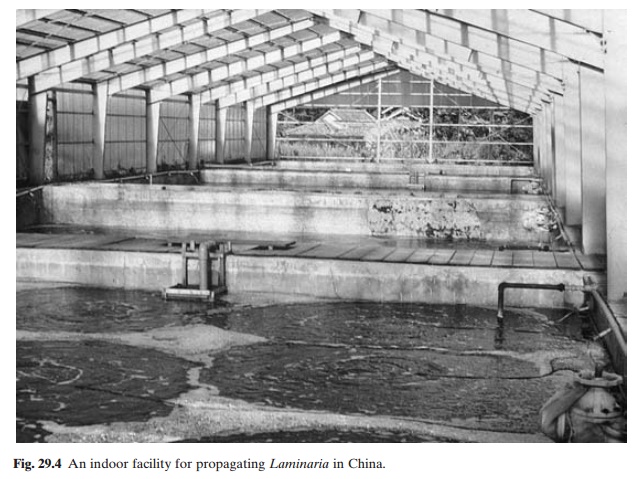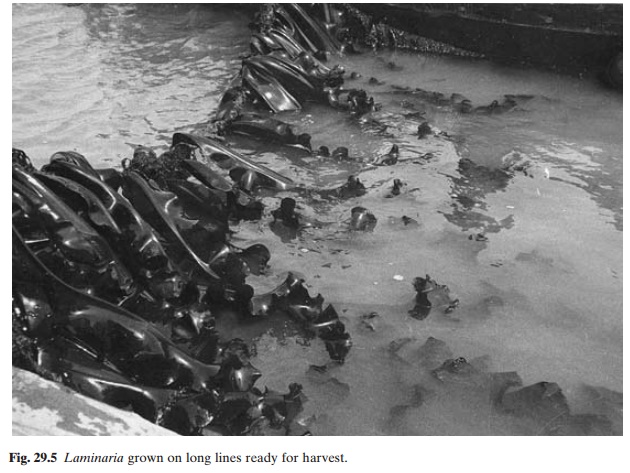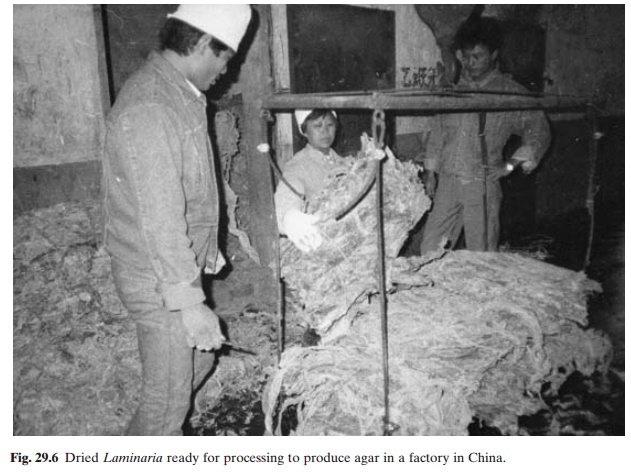Chapter: Aquaculture Principles and Practices: Seaweeds
Culture of Laminaria - Seaweeds
Culture of Laminaria
Laminaria japonica, known as ‘Kombu’, is animportant edible seaweed and a source of
alginic acid in Japan. China was a major importer of Japanese and Korean Laminaria until about the 1930s, when a
local source of the alga was discovered, and in recent years its cultivation
has expanded very rapidily.
The reproductive cycle of the species involves a long sporophyte
generation and a very short gametophyte generation of about two weeks. The
mature sporophytes form sori from which motile zoospores are released which
very soon attach themselves and germinate into male and female gametophytes.
The zygotes formed by the fusion of the eggs and sperm released by the
gametophytes develop into the sporophytes.
The earlier system of sowing spore-bearing rocks into the sea has been
partially replaced by the more intensive techniques of spore collection and
on-growing. In late autumn, special collectors made of split bamboo in the form
of short ladders are suspended from floating rafts. The zygotes which attach
themselves to the collectors develop into young sporophytes by about January.
Temperature and light intensity affect the formation and release of spores in
nature and, by controlling these factors, it is possible to propagate the
species indoors with consistent results (fig. 29.4). Temperatures between 10
and 15°C have been found to be favourable for the maturation of sporophytes and
formation of zoospores. At temperaturesabove 20°C, the production of new sori
and release of zoospores cease. Temperatures of 10–20°C have been found to be
suitable for the germination of spores and the formation of gametophytes.
Periodic darkness is necessary for release of eggs and sperm and successful
fertilization, but illumination is required for the development of the
gametophytes and the growth of the sporophytes. So periods of illumination of
500–4000m candelas, alternated with periods of darkness, have been recommended
in indoor propagation facilities.

Major increases in Laminaria
production in China are attributable to the use of the raft systems. Spores
attached to ropes are suspended from rafts either vertically or in a
cradle-like device made of bamboo, hung between two parallel rows of the bamboo
rafts. The main advantage of this arrangement is that the plants grow upwards
and therefore have better exposure to sunlight. Immersion of the sporophytes in
a fertilizer solution, such as ammonium nitrate, before they are attached to
the rafts promotes an early start to rapid growth. The use of spores produced
in summer under controlled conditions and cultured in mid-autumn when
temperatures fall below 20°C has greatly improved growth rates and reduced
fouling. The yield of a basket raft is reported to be only about 1kg per kg
fertilizer used, whereas the bamboo rafts yield over 3kg per kg fertilizer.
However, the quality of the basket raft plants is said to be higher.
In more exposed areas of the sea, long lines are now commonly used for
the cultivation of Laminaria in
China. As mentioned earlier,polyculture with scallops and abalones is presently
practised. Application of fertilizer is by spraying and this helps in the
faster growth of Laminaria as well as
scallops and abalones.
Predation and fouling as well as rot diseases have been oberved, but no
practical methods of prevention are known at present. Bottom culture of Laminaria on stones and ropes is still
practised in China, but the zoospores are first attached to the substrates
before being deposited on the sea bed.
Laminaria japonica grows under favourableconditions to lengths of over 3m in four to five
months (fig. 29.5). This size is suitable for harvesting, although the plants
can grow up to 6m on rafts. While harvesting of raft-grown Lami

is performed from boats, efficient harvesting in bottom cultures is
possible only by diving. Periodic harvesting of the distal one-third of the
sporophytes has been found to facilitate better growth and higher yields. The
farmer is especially interested in the dry weight rather than the wet weight of
the harvested plants, and the dry weight is reported to increase at water
temperatures of 20–21.5°C, even when the wet weight shows a decline (fig.
29.6). The reported yield of Laminaria
in bottom culture is about 2.4 tons/ha. A single bamboo raft can culture about
72000–134000 plants per ha.

Related Topics